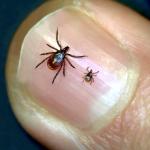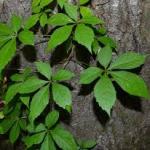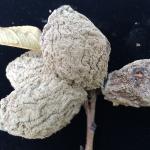A monthly e-newsletter from UMass Extension for landscapers, arborists, and other Green Industry professionals.
To read individual sections of the message, click on the section headings below to expand the content:
Hot Topics
2018 Green School Registration Has Begun!
UMass Extension's Green School is a comprehensive certificate short course for Green Industry professionals taught by UMass Extension specialists and University of Massachusetts faculty.
Location: Doubletree Hotel, Milford, MA
Dates: October 29 - December 13, 2018, twice weekly from 9:00 am to 3:30 pm
http://ag.umass.edu/landscape/education/umass-extensions-green-school
Designed for landscapers, lawn care specialists, nursery operators, sports field managers, public and private grounds managers, arborists and others in the green industry, our comprehensive course is for horticultural professionals who want to gain an understanding of economically feasible and environmentally responsible plant and land care practices and the relation of those practices to protecting the environment. Both experienced professionals as well as those entering the green industries will benefit from this course.
THREE SPECIALTY TRACKS TO CHOOSE FROM
- Landscape Management
- Turf Management
- Arboriculture
Green School teaches sensible and sustainable methods of plant and land care as well as responsible nutrient and pest management. You will learn scientifically sound information that will enable you to make better purchasing and management decisions, and to be a better steward of the environment. The curriculum, which emphasizes a systems-based approach to plant care, is based on current research and focuses on environmental stewardship, Best Management Practices (BMPs) and integrated pest management (IPM), and will enable you to develop an understanding of how proper management practices can enhance conservation of precious natural resources such as soil and water.
Green School is taught by University of Massachusetts Extension Specialists and UMass faculty. Instruction is done via classroom style lecture and interactive activities, and is supplemented through online resources via an online learning management system.
For more details or a registration form, go to www.umasgreeninfo.org or call (413) 545-0895.
Ticks Are Active!
 Remember to take precautions when working outdoors and to conduct daily tick checks. In July, the VERY tiny larval and nymph stages of blacklegged or "deer" ticks are active. For info on how to protect yourself, go to http://www.tickencounter.org/prevention
Remember to take precautions when working outdoors and to conduct daily tick checks. In July, the VERY tiny larval and nymph stages of blacklegged or "deer" ticks are active. For info on how to protect yourself, go to http://www.tickencounter.org/prevention
The UMass Amherst Laboratory of Medical Zoology tests ticks for Lyme Disease and other tick-borne pathogens. Visit the Tick Report website for more information.
Do you know which tick is which? Go to http://www.tickencounter.org/tick_identification/tick_species
2018 Massachusetts Landscape and Nursery Industry Survey
What are the needs and impacts of our landscaping and nursery businesses?
Please take our survey!
The goal of this survey is to gather information on the issues most important to the landscape and nursery industries in Massachusetts. This information will be used by researchers and Extension Educators at the University of Massachusetts to:
- Develop industry-focused research
- Create needed programming to support the industry
- Provide an overview of the state of the industry
This survey will not only help to focus research efforts, but will also provide insight on how national and state regulations and public perceptions of issues such as the impact of landscapes and plant production on pollinators are impacting the industry in Massachusetts.
The survey should take 10-15 minutes to complete.
Questions & Answers
Q. I am going to be spraying RoundUp ProTM. Do I need to add a surfactant to the tank?
A. RoundUp ProTM has a surfactant packaged in with the product, so it is not necessary to add a surfactant. Surfactant should ONLY be added if the product label states that one is needed. If a surfactant is added when it is not required, you can lose herbicide selectivity; in other words, tolerant plants may be injured or killed. This is especially true if tolerant plants are stressed by heat or dry growing conditions. If a product with a manufacturer-added surfactant (product A) is tank-mixed with an herbicide product that does not require a surfactant (product B), the surfactant in product A will act as a surfactant for product B, sometimes resulting in turf or ornamental injury from product B. As a rule, “if the product label calls for a surfactant, then one should be added; if it does not, then do not add one”. Distributors that sell a specific herbicide product will also sell the appropriate surfactant to be used with that product.
 Q. A customer claims he received a rash similar to poison ivy. After inspecting the property, I did not see any poison ivy. I did see Virginia creeper in the areas where he was gardening. Is it possible that his rash was associated with Virginia creeper?
Q. A customer claims he received a rash similar to poison ivy. After inspecting the property, I did not see any poison ivy. I did see Virginia creeper in the areas where he was gardening. Is it possible that his rash was associated with Virginia creeper?
A. While it is not common, Virginia creeper (Parthenocissus quinquefolia) can produce a rash similar to poison ivy. It is nothing to be alarmed about, as it is not common. Allergic reactions to plants, like food, vary from person to person.
Q. I manage a property with a large number of ornamental beds where groundcovers cover the area between the ornamental plants. These areas have a large number of perennial grassy weeds either growing in them or creeping in from the adjacent lawn. What is the best way to control these grassy weeds?
A. There are several herbicide products that are available for the control of grassy weeds in ornamental groundcovers. They are known as graminicides and are used over-the-top of groundcovers and broadleaf ornamentals for the control of annual and perennial grassy weeds. Fenoxaprop, sethoxydim, fluazifop and clethodim are the materials found in these products. Clethodim, sold under the tradename Envoy PlusTM, is the best choice for perennial grass control. Consult the label in order to be sure that that the groundcovers and ornamentals in these area are tolerant to an over-the-top application of Envoy PlusTM.
Randy Prostak, UMass Extension Weed Specialist
Trouble Maker of the Month
Brown Rot of Stone Fruits Caused by Monilinia fructicola
Brown rot is a disease that affects the shoots, foliage and fruit of hosts in the genus Prunus (cherry, plum, apricot, nectarine and peach). Blossom and foliar wilt, fruit rot, oozing stem cankers and branch dieback can result from infection.
The fungus often becomes established on blossoms soon after germination and then lingers in the tree canopy all season long. Whenever environmental conditions are favorable, Monilinia produces large masses of spores that are splashed or washed onto twigs and fruit, initiating new disease centers. Infected blossoms and fruit often have a very conspicuous, brown-colored, powdery coating present. These are long chains of lemon-shaped spores produced by the fungus. Stem cankers are accompanied by copious production of gum around the wound.
All Prunus species produce amber-colored gum in response to injury (biotic or abiotic) on woody parts, a process that is known as gummosis. The pathogen can overwinter within stem cankers, blighted leaves and fruit, especially fruit that has fallen to the ground around the base of the tree. Rotted, diseased fruit (sometimes known as “mummies”) may be held in the canopy, providing a large inoculum source the following season if they aren’t removed.
Prune and discard the blighted leaves, fruit and stems to reduce Monilinia inoculum within the tree canopy. Also, prune to maintain an open crown that maximizes sunlight on each fruit-bearing branch and improves air circulation. This will promote foliage drying and limit the environmental conditions conducive for infection. If spring conditions are particularly wet, then chemical management may be necessary to control brown rot.
Nicholas J. Brazee ,UMass Extension Plant Pathologist
Plant of the Month
Clethra alnifolia, Sweet Pepperbush or Summersweet Clethra
Unlike the spring, when there are hundreds of species of woody plants in bloom, mid to late summer may prove to be more of a challenge for finding colorful woody flowering trees and shrubs, but they are there.
Actually, there are a number of woody plants that bloom, or begin to bloom, in July: Oxydendron arboreum (sourwood tree - native); Albizia julibrissin; Aesculus parviflora (bottlebrush buckeye - native); Indigofera kirilowii (indigo); Indigofera amblyantha (Chinese indigo); Hydrangea macrophylla; Hydrangea quercifolia (oakleaf hydrangea – native); Hydrangea arborescens (smooth hydrangea - native); Hydrangea paniculata (panicle hydrangea); and Clethra alnifoilia.
Clethra alnifoilia, Sweet Pepperbush or Summersweet Clethra, is an outstanding native shrub for mid-late summer bloom, as it begins to bloom in mid-late July into August. With about four weeks of bloom, this makes it a great Plant of the Month for July!
Clethra alnifolia is a multi-stemmed deciduous shrub standing 4-8 feet high with a width that is equal to that or greater. It is a shrub with a suckering habit and is able to spread and colonize wide areas, especially in moist soil conditions. Preferring full sun to partial shade, it is site adaptable, growing in sun or shade, is tolerant of seaside conditions, and although it favors acidic, moisture-retentive organic soils, it is fairly drought tolerant. It has no significant insect or disease problems and is winter hardy to zone 4.
If those aren’t enough favorable attributes to select Clethra alnifolia, consider that the individual creamy-white, 1/3 inch, star-like flowers are arranged in upright racemes waving above the foliage like candles. These flowers are not only lovely to look at, but they are also exceedingly fragrant and flower for 4-6 weeks, filling the summer landscape with delightful perfume. Bees, butterflies and hummingbirds are attracted to the flowers, which provide nectar for pollinators and a benefit to wildlife.
Summersweet Clethra produces slightly glossy, medium to deep green leaves, 1 ¼ to 4 inches long and ¾ to 2 inches wide. In the fall, the foliage turns a rich butter-gold yellow, adding terrific color to the autumn landscape.
There are numerous cultivars of Clethra alnifolia, including more compact cultivars like ‘Hummingbird’, ‘Sixteen Candles’, and ‘Compacta’ (‘Nana’), or pink flowering cultivars like ‘Ruby Spice’ (a Cary Award winner), ‘Rosea’, and ‘Pink Spires’.
Summersweet Clethra may be used in a shrub border, naturalized area, shade gardens, seaside gardens, urban areas, wet areas, mass planting, woodland gardens, etc. Its many attributes - native plant, fragrant flowers, long bloom period, site adaptability, no significant pest problems, cold hardiness, colorful fall color, pollinator plant, low maintenance - make Clethra alnifolia a good choice for the summer.



Deborah C. Swanson, Horticultural Consultant
Upcoming Events
Landscape Pests and Problems Walkabout - Insects and Cultural Practices
Get some hands-on experience scouting and identifying for landscape insect and abiotic problems. Join Tawny Simisky, Extension Entomologist, and Russ Norton, Horticulture and Agriculture Extension Educator, for a walk through the landscape as they examine some of the most common insect and cultural problems of woody ornamentals, as well as discuss and demonstrate how to put IPM practices to work efficiently. Dress for walking; workshop held rain or shine. Bring a clipboard, pencil and hand lens if possible.
- When: Wednesday, July 11, 2018; 3:00 - 5:00pm
- Where: Elm Bank, Wellesley, MA
- Registration
Other Upcoming Events:t
- 6/15: Green School registration begins
- 8/9: Landscape and Forest Tree and Shrub Insect Workshop
- 9/11: Emerald Ash Borer Field Day
For more information and registration for any of these events, go to the UMass Extension Landscape, Nursery, and Urban Forestry Program Upcoming Events Page.
Additional Resources
For detailed reports on growing conditions and pest activity – Check out the Landscape Message
For commercial growers of greenhouse crops and flowers - Check out the New England Greenhouse Update website
For professional turf managers - Check out Turf Management Updates
For home gardeners and garden retailers - Check out home lawn and garden resources. UMass Extension also has a Twitter feed that provides timely, daily gardening tips, sunrise and sunset times to home gardeners, see https://twitter.com/UMassGardenClip
Diagnostic Services
A UMass Laboratory Diagnoses Landscape and Turf Problems - The UMass Extension Plant Diagnostic Lab is available to serve commercial landscape contractors, turf managers, arborists, nurseries and other green industry professionals. It provides woody plant and turf disease analysis, woody plant and turf insect identification, turfgrass identification, weed identification, and offers a report of pest management strategies that are research based, economically sound and environmentally appropriate for the situation. Accurate diagnosis for a turf or landscape problem can often eliminate or reduce the need for pesticide use. For sampling procedures, detailed submission instructions and a list of fees, see Plant Diagnostics Laboratory
Soil and Plant Nutrient Testing - The University of Massachusetts Soil and Plant Nutrient Testing Laboratory is located on the campus of The University of Massachusetts at Amherst. Testing services are available to all. The function of the Soil and Plant Nutrient Testing Laboratory is to provide test results and recommendations that lead to the wise and economical use of soils and soil amendments. For complete information, visit the UMass Soil and Plant Nutrient Testing Laboratory web site. Alternatively, call the lab at (413) 545-2311.

